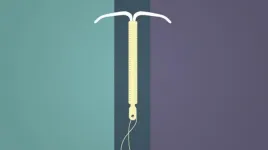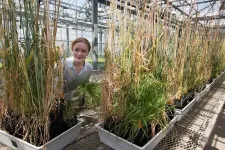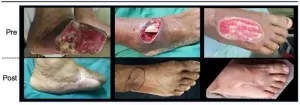INFORMATION:
Title: The costs of human uterus transplantation: a study based on the nine cases of the initial Swedish live donor trial, https://doi.org/10.1093/humrep/deaa301
Contacts:
Mats Brännström, tel. +46 36 254 455, email mats.brannstrom@obgyn.gu.se
Thomas Davidson, tel. +46 709 200 344, email thomas.davidson@liu.se
Lars Sandman, email lars.sandman@liu.se
Estimating costs of uterine transplantation
2021-04-07
(Press-News.org) Sweden's acclaimed research on uterine transplants has taken a new step forward: into the field of health economics. Now, for the first time, there is a scientifically based estimate of how much implementing the treatment costs.
The current research is based on the nine uterine transplants from living donors carried out in 2013, under the leadership of Mats Brännström, Professor of Obstetrics and Gynecology at Sahlgrenska Academy, University of Gothenburg, and Chief Physician at Sahlgrenska University Hospital.
The transplants were performed within the scope of the world's first systematic, scientifically based study in the field. After the first birth in Gothenburg in 2014, there were a further seven births before a woman outside Sweden had a baby after a uterine transplant.
Now that the survey of costs is complete, the results have been reported with certain reservations. First, the number of cases studied is restricted to nine; second, the treatment has taken place as part of a research project, subject to the requirements this has entailed. Nonetheless, the study represents an initial indication of costs.
The researchers arrived at a total average sum per transplant, now reported in the journal Human Reproduction, of EUR 74,564 in current monetary value. This figure comprises costs relating to the recipient and donor alike.
The total includes, first, screening examinations and treatments, such as in vitro fertilization (IVF), in the year preceding the transplant; second, the actual operations on the donor and recipient; and third, costs in the two months after the transplant, including sick leave.
Sick leave (25.7%) was the single largest item in the cost calculation. The other categories were postoperative inpatient care (17.8%), surgery (17.1%), preoperative examinations (15.7%), anesthesia (9.7%), medication (7.8%), postoperative testing (4.0%), and readmission to hospital (2.2%).
The total is described as relatively high, due partly to the extensive scientific requirements. In a future clinical setting, the researchers say, aggregate transplant costs would likely be lower.
Thomas Davidson, Associate Professor in the area of Health Economics and Health Technology Assessment at Linköping University, and first author of the study, puts the matter in perspective.
"In terms of priorities, this study is important because it contributes key data for deciding whether to offer uterine transplants within publicly funded health care. A cost estimate is the starting point for upcoming assessment of whether the intervention is cost-effective."
Cost-effectiveness is usually measured in terms of cost per quality-adjusted life year (QALY) gained -- a yardstick that combines economic aspects with longevity and quality of life.
"In assessing cost-effectiveness, we have to relate both costs and effects, preferably measured in QALYs, to those of alternative treatments," Davidson says.
Lars Sandman -- Professor of Health Care Ethics, head of the Centre for Priority Setting in Health Care at Linköping University, and the study's co-author -- adds his comments.
"There are still essential issues we want to keep investigating. One is how we should regard the effects of a uterine transplant. Should the QALY gain generated include only the benefit to the mother of getting pregnant, giving birth and being the child's parent? Or should the benefit of a child being born and living on for a number of years, adding QALYs, be included as well? It makes a big difference in terms of the cost-effectiveness of the intervention, which is an important factor in the priority-setting context."
Professor Mats Brännström, corresponding author, sums up.
"All the costs of investigation, staff, and hospital care were funded through research grants. The grand total is close to what we'd calculated, and comparable to the current cost of kidney transplantation from a living donor. In all probability, future uterine transplantation will be more cost-effective thanks to the robot-assisted surgical technique we've developed, which means shorter hospital stays and patients returning to work sooner."
ELSE PRESS RELEASES FROM THIS DATE:
Training in compassion improves the well-being of relatives to people with mental illness
2021-04-07
If relatives of people with mental illness become better at accepting the difficult emotions and life events they experience - which is what training in compassion is about - their anxiety, depression and stress is reduced. These are the results of a new study from the Danish Center for Mindfulness at Aarhus University.
Being a relative of a person with a mental illness can be very burdensome. It can feel like a great responsibility, and many people struggle with feelings of fear, guilt, shame and anger. A new study from the Danish Center for Mindfulness shows that eight weeks of training in compassion can significantly improve the well-being of relatives.
Compassion is a human quality that is anchored in the recognition of and desire to relieve ...
Myositis-specific autoreactive T cells are pathogenic for dermatomyositis
2021-04-07
Tsukuba, Japan - Dermatomyositis is an idiopathic inflammatory myopathy that has been regarded as an autoimmunity-based disorder, although its pathogenesis remains unclear. In this study, researchers from the University of Tsukuba used a mouse model to identify a mechanism by which dermatomyositis may develop in humans. The animal model and findings can be used to better understand the disease and develop disease-specific treatments.
Dermatomyositis belongs to a group of idiopathic inflammatory myopathies that are associated with the presence of specific autoantibodies in patient sera. Multiple myositis-specific autoantibodies, which target proteins ubiquitously expressed in the nucleus or cytoplasm, have been described. One ...
Scientists develop eco-friendly pollen sponge to tackle water contaminants
2021-04-07
A team of scientists led by Nanyang Technological University, Singapore (NTU Singapore) has created a reusable, biodegradable sponge that can readily soak up oil and other organic solvents from contaminated water sources, making it a promising alternative for tackling marine oil spills.
Made of sunflower pollen, the sponge is hydrophobic - it repels water - thanks to a coat of natural fatty acid on the sponge. In lab experiments, the scientists showed the sponge's ability to absorb oil contaminants of various densities, such as gasoline and motor oil, ...
Black hole pairs found in distant merging galaxies
2021-04-07
Astronomers have found two close pairs of quasars in the distant Universe. Follow-up observations with Gemini North spectroscopically resolved one of the distant quasar pairs, after their discovery with the Hubble Space Telescope and Gaia spacecraft. These quasars are closer together than any pair of quasars found so far away, providing strong evidence for the existence of supermassive black hole pairs as well as crucial insight into galaxy mergers in the early Universe.
The quasars in each of the two pairs are separated by just over 10,000 light-years, suggesting ...
A few hundred dollars makes a difference in use of long-lasting birth control
2021-04-07
Getting a birth control implant used to cost some women hundreds of dollars, if they were among the nearly half of privately insured Americans covered by a health plan with a high deductible that they were responsible for paying.
But a new study in the April issue of Health Affairs shows that after the Affordable Care Act's no-cost birth control provision took effect in 2013, women in these high-deductible health plans (HDHPs) opted for long-acting contraception even more than women with other types of health plans.
The study's findings have important policy implications, because employers now have the ability to opt out of the birth control portion of the ACA, following a Supreme Court case decided in 2020. Many employers have shifted to HDHPs to hold down their overall health ...
Wild barley from Jordan holds key to stem rust resistance
2021-04-07
Stem rust is a devastating disease of cereal crops, including barley, one of the first domesticated crops in agriculture and the fourth most widely grown crop in the world. Barley is unique because it is one of only a few crops that can be cultivated in almost any climate and across a range of elevations, making it economically and nutritionally important.
Stem rust is one of the biggest threats to barley production and capable of causing complete crop loss during severe epidemics. And since barley is also used as malt for beer and spirits and feed for animals ...
Is combat-induced post-traumatic stress disorder unique to industrialized warfare?
2021-04-07
Thirty years ago, clinical psychiatrist Jonathan Shay drew attention to similarities between the trauma experienced by the Greek warriors, as documented in the epic poem "The Iliad," and Vietnam veterans in America. Could the experience of war impact people in similar ways in vastly different cultural milieus?
Research published this week by ASU researcher Sarah Mathew and former ASU postdoctoral researcher Matthew Zefferman in the Proceedings of the National Academy of Sciences shows that Turkana pastoralist warriors from Kenya also experience PTSD (post-traumatic stress disorder) symptoms, even though their lifestyles and combat experiences are ...
Aquatic ecosystems source of half of global methane emissions
2021-04-07
Direct human alterations to natural aquatic ecosystems can increase methane emissions, a new study has found.
Atmospheric methane has tripled since pre-industrial times. It traps heat far more effectively than carbon dioxide and accounts for 25% of atmospheric warming to date. And much of that methane is coming from aquatic ecosystems, with human activities contributing to the emissions levels, a new paper published in Nature Geoscience has found.
The global contribution and importance of aquatic ecosystems as methane emitters has been underestimated, ...
How the spinifex got its hole
2021-04-07
Anyone who has visited the Australian outback would be familiar with spinifex grasses, which cover almost a fifth of our continent.
Like many scientists, they may have also wondered why this iconic arid grass grows in striking ring shapes.
Previous studies have tested whether spinifex rings could be caused by termites, water availability or nutrient depletion, but none has provided a convincing explanation.
Now scientists from UNSW Sydney have found that pathogenic soil microbes play a role in how the spinifex got its hole.
Their study, the first of its kind in an arid ecosystem, has been published in the Australian Journal of Botany.
Professor Angela Moles and Neil Ross from ...
Stem cell therapy research could help patients with non-healing diabetic foot ulcers
2021-04-07
Durham, NC - According to the results of a phase 1 clinical trial just published in STEM CELLS Translational Medicine, a new stem cell therapy shows promise of making diabetes-related amputations a thing of the past. The trial involved injecting diabetes patients suffering from non-healing diabetic foot ulcers (DFU) with a cell preparation containing adult stem cells harvested from their own fat. The results showed that the treatment induced regeneration of the blood vessels surrounding the DFUs, accelerated healing - all with no serious side effects.
"Non-healing diabetic foot ulcers usually ...




